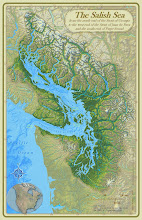 |
'Indicator Species Series: Mussels' 2.5" diameter, sterling
silver, paper, colored pencil, mica; Kathleen Faulkner |
'An indicator species is any biological species that defines a trait or characteristic of the environment. For an example, a species may delineate an ecoregion or indicate an environmental condition such as a disease outbreak, pollution, species competition or climate change. Indicator species can be among the most sensitive species in a region, and sometimes act as an early warning to monitoring biologists.'
Wikipedia
Here is a short list:
Mussels, clams and oysters are susceptible to toxins, pollutants and minute changes in environmental conditions.
Mosses often indicate acid soil.
The northern spotted owl indicates old growth forests.
Lichens are indicators of low air pollution.
Tubificid worms are indicators of sewage seepage. (does Victoria, Canada have an abundance of these?)
Adult frogs and toads absorb through their skin and are indicators of water pollution.
Salmon are an indicator species for wetland ecosystems
Non-Alaskan grizzly bears are indicators of mountain ecosystems, measuring the health and diversity of the ecosystem.
In the pacific northwest, the environmental health of estuaries is monitored by the indicator species of
eel grass.
Kelp is a foundation species and can be used as an indicator of other species occurring in the environment.
Maybe this is something you'll give a little thought to as you go about your day.




















































